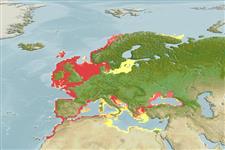>
Gobiiformes (Gobies) >
Gobiidae (Gobies) > Gobiinae
Etymology: Aphia: Greek, aphia, -as = a kind of plant (Tussilago sp.) (Ref. 45335).
More on author: Risso.
Environment: milieu / climate zone / depth range / distribution range
экология
морской; солоноватоводный; мигрирует в океане (Ref. 51243); пределы глубины 0 - 97 m (Ref. 57814), usually 5 - 80 m (Ref. 57814). Subtropical; 13°C - 16°C (Ref. 57814); 70°N - 25°N, 13°W - 42°E
Atlantic Ocean: Trondheim to Morocco. Also known from the Mediterranean including Black Sea and the Azov Sea (Ref. 57814).
Length at first maturity / Size / Вес / Возраст
Maturity: Lm 3.8, range 3 - ? cm
Max length : 7.9 cm TL самец/пол неопределен; (Ref. 26260); наибольший возраст (опубликованны данные): 1.00 годы (Ref. 232)
колючие лучи спинного плавника (общее число) : 4 - 6; членистые (мягкие) лучи спинного плавника (общее число) : 11 - 13; колючие лучи анального плавника: 1; членистые (мягкие) лучи анального плавника: 11 - 15. Transparent body, more or less reddish, with chromatophores along bases of median fins and on head. Vertebrae 26-28 (Ref. 232). Males with longer dorsal and anal fins than females (Ref. 35388).
Benthic and free swimming (Ref. 92840). A neotenic, pelagic species inhabiting inshore and estuarine waters, over sand, mud and eel-grass (Ref. 4343). Adults feed on zooplankton, especially copepods, cirripede larvae and mysids (Ref. 4343). They spawn in summer in empty bivalve shells (Ref. 35388). Probably migrate to deeper water to spawn during summer (Ref. 57814). Adults die after breeding (Ref. 4696) which does not qualify as a manifestation of semelparity but abbreviate iteroparity according to a recent study (Ref. 81039). Eggs are pear-shaped (Ref. 4696).
Single spawner, all oocytes in the ovaries grow at a similar rate (Ref. 57814). However, a recent study showed that this species breeds at least twice during its short lifespan with batches of oocytes at different vittelogenic stages in the ovary (Ref. 81039). Reproduction is of the abbreviate iteroparous type with more than one spawning per reproductive season (in spring and summer in older females, in summer and autumn in the yougner ones) (Ref. 81039).
Maugé, L.A., 1986. Gobiidae. p. 358-388. In J. Daget, J.-P. Gosse and D.F.E. Thys van den Audenaerde (eds.) Check-list of the freshwater fishes of Africa (CLOFFA). ISNB, Brussels; MRAC, Tervuren; and ORSTOM, Paris. Vol. 2. (Ref. 4343)
Статус Красного Списка МСОП (Ref. 130435)
Угроза для людей
Harmless
Использование человеком
рыболовство: коммерческий
дополнительная информация
инструменты
Специальные отчеты
Скачать в формате XML
ресурсы в Интернет
Estimates based on models
Preferred temperature (Ref.
123201): 7.6 - 18.6, mean 10.8 °C (based on 1452 cells).
Phylogenetic diversity index (Ref.
82804): PD
50 = 1.0000 [Uniqueness, from 0.5 = low to 2.0 = high].
Bayesian length-weight: a=0.00525 (0.00458 - 0.00602), b=3.09 (3.05 - 3.13), in cm total length, based on LWR estimates for this species (Ref.
93245).
Trophic level (Ref.
69278): 3.1 ±0.28 se; based on food items.
устойчивость к внешним воздействиям (Ref.
120179): высокий, минимальное время удвоения популяции до 15 месяцев (K>0.3; tm=1; tmax=1; Fec = 935).
Fishing Vulnerability (Ref.
59153): Low vulnerability (12 of 100).
Nutrients (Ref.
124155): Calcium = 395 [175, 1,059] mg/100g; Iron = 2.75 [1.16, 5.97] mg/100g; Protein = 18.4 [16.2, 20.3] %; Omega3 = 0.294 [0.105, 0.828] g/100g; Selenium = 29.2 [9.5, 91.1] μg/100g; VitaminA = 9.18 [1.88, 40.11] μg/100g; Zinc = 2.41 [1.43, 3.95] mg/100g (wet weight);
